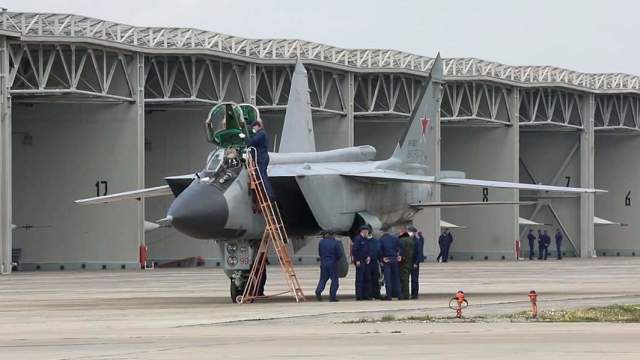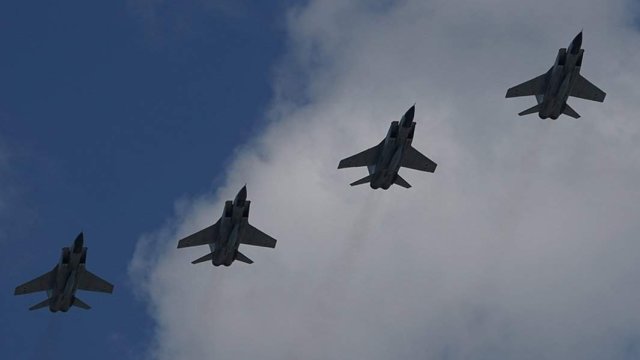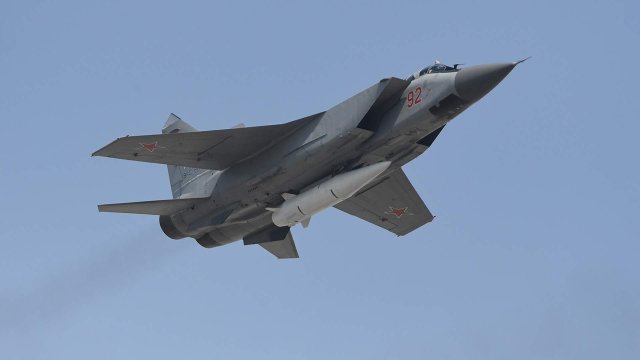A unique Russian missile has become an essential component of NATO's deterrence. Russian hypersonic Kinzhal missiles have entered permanent combat duty in Kaliningrad for the first time.
On August 18, the military department distributed a video of the flight of three MiG—31 fighter carriers that landed at the Chkalovsky airfield in the Kaliningrad region. As stated in the Ministry of Defense, this deployment was carried out "as part of the implementation of additional strategic deterrence measures." Although the Dagger has already managed to take part in a special military operation, it still remains one of the most closed systems in the arsenal of the Russian army. Izvestia investigated how this project developed, what are the prospects for the development of the Dagger and why the X-47M2 index, which the system allegedly carries, is fake.
The way to the West In the Ministry of Defense of Russia on August 18, 2022, it was reported that three supersonic MiG-31 aircraft with hypersonic Kinzhal missiles were relocated to the Kaliningrad region at the Chkalovsk airfield.
This is the first time that the newest complex of weapons with hypersonic weapons appeared in the westernmost point of the Russian Federation.
"Dagger" today remains one of the most secret developments of the Russian rocket and aviation industry. Nevertheless, after its premiere, in a memorable speech by Russian President Vladimir Putin to the Federal Assembly on March 1, 2018, some details about the latest weapons system have already become known.

MiG-31K fighter with hypersonic missiles "Dagger"
Image source: Photo: RIA Novosti/The Ministry of Defense of the Russian Federation Complex 9-A-7660 "Dagger" with a hypersonic missile and a MiG-31 carrier aircraft was developed in 2000-2010 by the Kolomna Design Bureau of Mechanical Engineering together with the RSC MiG.
The choice of the aircraft is not accidental: it is such a machine as the MiG-31 that can serve not only as a carrier and launch platform, but also as the first upper stage. The Engineering Design Bureau is widely known for its Iskander-M ground-based multifunctional complex with the 9M723 solid-fuel aeroballistic missile, and, apparently, it was she who served as the prototype of the Dagger. This is a very compact rocket, it carries different types of combat units and can be launched at any altitude and at any initial speed of the carrier. It remained only to refine the control system and learn how to aim a missile suspended under the plane. As a result, an air missile system was created that has no analogues in the world.
The exact TTX systems have not been published in the open press. However, it is known that the range of the complex is about 2 thousand km, and the maximum speed of the rocket can reach 10 speeds of sound. At the time of launch from such a carrier as the MiG-31, the rocket already has a flight altitude of about 20 km and a speed of at least 1500 km/h. Due to such starting conditions, the Dagger ammunition gets a record flight speed and range, which is several times longer than the range of the ground prototype.
A guaranteed Dagger strike flies along an aeroballistic trajectory — that is, in dense layers of the atmosphere, the munition moves using the lifting force of a streamlined body, and in the discharged upper layers of the atmosphere — just like all other ballistic missiles, like a thrown stone.
This combination allows you to get the maximum range and unique anti-missile capabilities. After all, the warhead is controlled throughout the flight path using both aerodynamic rudders and using maneuvering micro-motors. This ensures high accuracy and creates maximum difficulties for the defense system of a potential enemy — after all, a missile that performs unpredictable maneuvers during flight is extremely difficult to shoot down. But that's not all. After installing the radar guidance head, the missile also becomes homing.

Photo: RIA Novosti/Ministry of Defense RF Image Source: iz.ru Most likely, the missiles of the complex are equipped with a radar guidance system and can hit not only fixed targets with coordinates known in advance, but also target moving objects such as an aircraft carrier or another ship.
Any large radio-contrast target will be found by such a missile, singled out among others and destroyed from the first hit.
The Dagger complex can be guaranteed to hit any ground and even protected target — the speed of the ammunition at the moment of falling exceeds 1 km/sec. No ground object can be protected from such a threat, even if it does not carry a nuclear charge. And with a penetrating nuclear warhead, it will be able to "uproot" any buried object such as a ballistic missile silo launcher or a stationary underground command post with one hit.
According to their capabilities, the Dagger complexes belong to strategic weapon systems, and it is not for nothing that the emblems of Long-range aviation of the Russian Aerospace Forces are visible on the MiG-31 carrier aircraft that arrived in Kaliningrad on August 18. According to information from the Ministry of Defense of the Russian Federation, "Daggers" are included in the composition of Long-range aviation. And today, in the ranks of the Russian Aerospace Forces, there is already a whole regiment of MiG—31 carrier aircraft, whose squadrons can be quickly transferred to any remote airfield and jump to the targets.

Photo: IZVESTIA/Pavel Bednyakov Image source: iz.ru Thus, the "Dagger" today is the newest means of rapid and high—precision response to almost any challenges from an arbitrarily strong opponent.
This type of missile systems is currently not in service in any army in the world. By the way, from the base near Kaliningrad, Daggers can hit targets in Europe, including the entire territory of France and the UK. From the Kola Peninsula, you can control the entire North Atlantic to Iceland. From Chukotka — the whole of Alaska, and from the Crimea — the central and eastern part of the Mediterranean Sea.
The legend of the "Dagger"
Having no time to appear in the public media space, the Dagger missile system immediately began to acquire legends. One of them is its supposedly official name "X-47M2". It is curious that the index in the designation system of equipment of the Armed Forces of Russia has never really existed.
The history of its appearance is as follows: in 2014, by mistake, in the retelling of the speech of the head of the Tactical Missile Armament Corporation, the designation "promising missile for the 5th generation PAK FA X-74M2 aircraft" appeared in the media. And indeed, the head of KTRV was talking about an air–to-air missile for the K-74M2 PAK FA, which was being worked on at that time. The "K" index is usually air–to–air ammunition, but the air-to-ground missile index usually begins with the letter "X". Because of this confusion, an even stranger index "X-47M2" appeared a little later. He turned out to be so similar to the truth that he remained in the masses and lives in the media space to this day.
Dmitry Kornev

